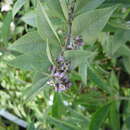en
names in breadcrumbs


Buddleja limitanea is a small deciduous shrub. Discovered by George Forrest in Yunnan (1912) and in northern Burma (1914), described by William Wright Smith in 1916.[1] Resembling a small B. forrestii and hence sunk under this name by Leeuwenberg,[2] although recognised in horticulture as a separate species.[3]
Buddleja limitanea grows to two metres in height in the wild and has small pendulous terminal panicles with relatively few flowers. The colour of the virtually scentless flowers is generally pink-purple, which appear in late summer. The grey-green lanceolate leaves, which have only sparing tomentum, are opposite and considerably smaller than those of B. forrestii.
Buddleja limitanea is fairly hardy in the UK, but still best grown against a south-facing wall, or in pots which can be removed to the greenhouse or conservatory in winter. Relatively common in cultivation in the UK, a specimen is grown as part of the NCCPG national collection at Longstock Park Nursery, near Stockbridge, Hampshire. Hardiness: USDA zones 8–9.[3]
Buddleja limitanea is a small deciduous shrub. Discovered by George Forrest in Yunnan (1912) and in northern Burma (1914), described by William Wright Smith in 1916. Resembling a small B. forrestii and hence sunk under this name by Leeuwenberg, although recognised in horticulture as a separate species.
Buddleja forrestii est une espèce de Buddleja appartenant à la famille des Buddlejaceae, nommée d'après le botaniste George Forrest (1873-1932) qui la découvrit en 1904 dans le Yunnan et l'introduisit en Europe[1],[2]. Cette espèce est largement distribuée de l'Inde septentrionale à la Chine occidentale.
Cette espèce a été étudiée par Ludwig Diels en 1912.
Buddleja forrestii peut croître jusqu'à six mètres de hauteur dans son habitat naturel. Ce buddléia se distingue par ses longues panicules terminales qui mesurent jusqu'à vingt-cinq centimètres de longueur. Ses fleurs presque sans parfum qui fleurissent à la fin de l'été peuvent varier du mauve au blanc[2],[3]. Ses branches tétragones portent des feuilles lancéolées et opposées, jusqu'à vingt-cinq centimètres de longueur. Le dessous est recouvert de poils d'un rouge brunâtre[1] 2n = 114[4]. .
En Europe, Buddleja forrestii apprécie plutôt les régions méditerranéennes. Dans les zones situées plus au nord, il doit être planté près d'un mur orienté au sud, ou abrité en serre en hiver, au nord de la France.
Buddleja forrestii est une espèce de Buddleja appartenant à la famille des Buddlejaceae, nommée d'après le botaniste George Forrest (1873-1932) qui la découvrit en 1904 dans le Yunnan et l'introduisit en Europe,. Cette espèce est largement distribuée de l'Inde septentrionale à la Chine occidentale.
Buddleja forrestii là một loài thực vật có hoa trong họ Huyền sâm. Loài này được Diels mô tả khoa học đầu tiên năm 1912.[1]
Buddleja forrestii là một loài thực vật có hoa trong họ Huyền sâm. Loài này được Diels mô tả khoa học đầu tiên năm 1912.
滇川醉鱼草(学名:Buddleja forrestii)为玄参科醉鱼草属的植物。分布于印度、缅甸、不丹以及中国云南、四川等地,生长于海拔1,800米至4,000米的地区,见于山地疏林中或山坡灌木丛中,目前尚未由人工引种栽培。
端丽醉鱼草(云南植物志) 苍山醉鱼草(云南种子植物名录)